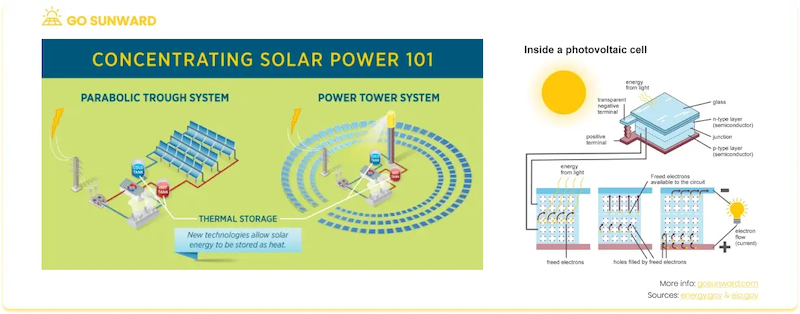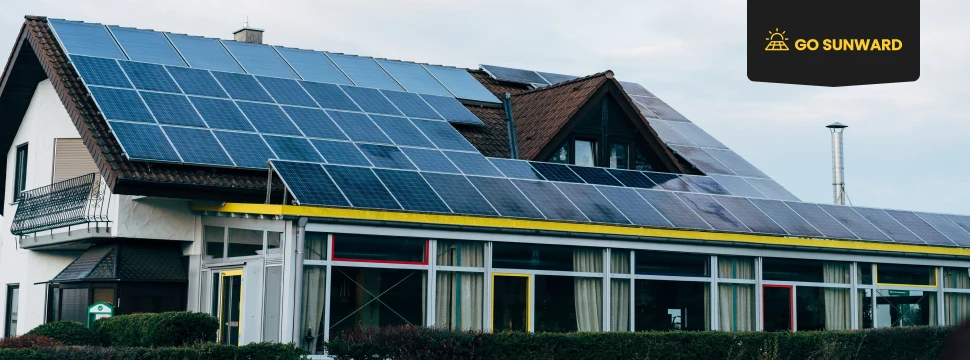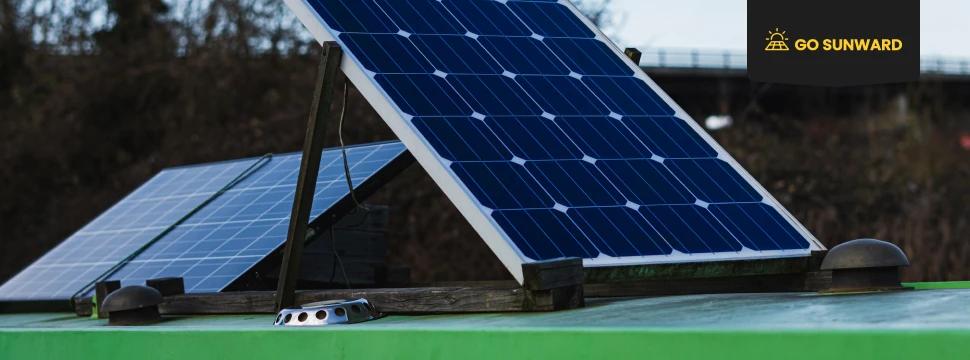Solar Inverters: Important Info To Know About Solar Inverters
As the world continues to transition towards sustainable energy sources, solar power has emerged as a front-runner to meet our future energy demands. One of the main advantages of solar panels is their ability to reduce carbon dioxide (CO2) emissions. Central to the functioning of solar power systems are solar inverters, which play a crucial job in converting the direct current (DC) generated by solar panels into alternating current (AC), which is the type of electricity we can use in our homes and businesses.
This article will briefly recap how solar electricity is generated and then delve into all the important information you need to know about solar inverters, their role in harnessing solar energy and key information about their potential installation in your house.
By providing a clear overview of solar inverters, their functions, and practical considerations for their implementation, this article aims to equip readers with the necessary knowledge to make informed choices about their solar energy journey.
A Quick Recap On Solar Electricity Generation
Solar technologies leverage the energy of sunlight through two primary methods: photovoltaic (PV) solar panels and solar Concentrated Solar Power (CSP) systems. These mechanisms either directly convert sunlight into electricity using PV panels or concentrate solar radiation using mirrors in CSP. For information on how this process works, click here. The resulting energy can serve for immediate electricity generation or can be preserved in batteries or thermal storage systems to best cater to future energy needs.
Both systems, CSP and photovoltaic systems, require solar panel inverters to convert the direct current (DC) electricity generated by the solar panels or CSP receivers into alternating current (AC) power, which is the standard form used in most households and businesses.

Solar Inverters 101
Let’s now delve into the fundamental basics of solar inverters:
What is a solar inverter?
A solar inverter, also known as a photovoltaic (PV) inverter, is a specialized power inverter that converts the variable direct current (DC) output generated by a solar energy system into an alternating current (AC) electricity with a utility frequency, suitable for powering homes and businesses. This conversion is crucial because most of our appliances and devices run on AC power. This AC output can either be integrated into a commercial electrical grid or utilized within a local, off-grid electrical network.
The role of solar inverters extends beyond mere conversion; it’s about optimizing energy generation and system efficiency to ensure optimal performance. By employing a monitoring approach, these devices constantly oversee the performance of solar panels, making dynamic adjustments to the conversion process. This real-time fine-tuning is pivotal in guaranteeing that the energy output remains at its prime, maximizing the solar system’s overall efficiency.
Moreover, solar inverters hold a dual role as the central nexus between the solar panels and the home’s electrical distribution panel. This strategic position enables them to play a pivotal role in the seamless functioning of the entire energy system. By embracing the latest technological advancements, modern inverters incorporate sophisticated switches that are able to link or isolate your solar energy setup from the power grid.

Types of solar inverters
There are three main types of solar inverters, each designed to cater to specific needs and applications: string inverters, micro-inverters, and power optimizers.
1) String inverters
These are the most common types of inverters and can be used in both residential and commercial settings. They efficiently link multiple solar panels together in a string configuration, transforming the collective DC power they generate into usable AC power. This method simplifies the setup and reduces the overall complexity of the system.
However, despite their widespread use, string inverters come with a notable drawback. The interconnection of panels in a string means that if any one panel’s performance declines, whether due to damage or shading, the overall performance of the entire array is susceptible to a corresponding drop. This dependency on the weakest link in the string can lead to suboptimal energy production and reduced efficiency.
2) Micro-inverters
Micro-inverters are gaining popularity as a preferred option for residential solar systems. These inverters are individually affixed to each solar panel and manage the conversion of DC to AC directly on the roof, eliminating the need for a separate inverter. With this decentralized conversion approach, any impact from the shade on one or more panels does not extend to those panels that are still beneffiting from sunlight. Furthermore, the ability to monitor the performance of each individual solar panel becomes feasible.
Microinverters also offer the advantage of optimizing roof space for solar panel installation. Even if some panels experience partial shading during certain times of the day, their diminished performance won’t affect the output of other panels that continuously receive ample sunlight.
While microinverters represent a newer technology and generally come at a higher cost compared to other inverter types, this additional investment might be balanced by the augmented energy production they can potentially facilitate.
3) Power optimisers
Similar to microinverters, power optimizers are gaining popularity due to their advantages, although they come at a slightly lower cost. These optimizers are situated on each individual solar panel, offering advantages comparable to microinverters.
However, their operational mechanism diverges: instead of executing the DC to AC conversion at the rooftop level, power optimizers channel the DC electricity to a central string inverter for the final conversion to AC power. This approach combines the benefits of individual panel optimization with the efficiency of a centralized inverter system.
An added benefit of power optimizers is the ability to closely monitor the performance of each individual panel through an online portal. This real-time insight enables users to track the health and efficiency of their solar panels, identifying and addressing any underperforming components promptly. In this way, power optimizers present a middle ground between the personalized efficiency of microinverters and the cost-effectiveness of string inverters, offering a solution that caters to both performance and budget considerations.
How much power can a solar inverter generate?
The power output of a solar inverter depends on several factors such as its size, efficiency, and the solar panel array it is connected to.
The size of a solar inverter is typically measured in kilowatts (kW) and can range from a few hundred watts for small residential systems to several megawatts for large commercial installations. The power rating of the solar inverter should be carefully matched with the capacity of the solar panel array to ensure optimal performance and efficiency.
The efficiency of a solar inverter is an important factor in determining how much power it can generate. Inverter efficiency refers to the percentage of DC power that is converted into usable AC power. Higher efficiency inverters can convert a larger proportion of the DC electricity generated by the solar panels, resulting in higher overall power generation.
The power output of a solar inverter is also dependent on the solar panel array it is connected to. The total power generation will vary based on the number and capacity of the solar panels, as well as external input factors such as sunlight intensity and temperature.
What are the benefits of using solar inverters?
Solar inverters play a critical role in converting the direct current (DC) generated by solar panels into usable alternating current (AC) electricity for your home or business. This vital component not only enhances the efficiency of your solar energy system but also provides a range of benefits that make investing in a solar inverter an appealing option.
1. Efficient energy conversion: Solar inverters are designed to optimize energy conversion from DC to AC. By ensuring maximum efficiency, solar inverters enable you to harness the full potential of your solar panels, ultimately leading to higher energy production and increased cost savings over time.
2. Grid compatibility: Solar inverters are grid-tied, meaning they enable you to connect your solar energy system to the utility grid. This allows for seamless integration between your solar panels and the electrical grid, allowing excess energy to be fed back into the grid and potentially earn you credits or compensation through net metering programs.
3. Power output regulation: Solar inverters are equipped with advanced power electronics that regulate the output of your solar energy system. This ensures a steady and stable supply of electricity, protecting your appliances from voltage fluctuations and ensuring optimal performance.
4. Monitoring and data analysis: Many modern solar inverters come with built-in monitoring systems that allow you to track the energy production of your solar panels in real time. This data can be accessed remotely through mobile apps or web portals, providing valuable insights into your energy consumption patterns.
Major players in the solar inverter market
The solar inverter market is competitive and is made up of several major players who are well-established and renowned in the industry. According to our research, five major manufacturers – Huawei, Sungrow, SMA, Power Electronics, and FMER – dominate the market with over 50% of the global share of solar PV inverter business. Other well-known companies in the invertor space are TMEIC, Ginlong Technologies, Growatt New Energy, SolarEdge Technologies, Enphase Energy, and Sineng Electric Co.
While these are the dominant companies now, it is important to note that the solar industry is in a constant state of flux, with the positions of companies frequently shifting. Technological breakthroughs can rapidly alter the landscape, propelling innovative companies to the forefront while causing others to reassess their positions. Market trends, such as changes in consumer preferences, governmental policies, and environmental awareness, can also significantly impact a company’s position in the solar technology sector.
Installing A Solar Inverter In Your Own Home
We have taken an in-depth look at what solar inverters are, how they work, and who the major players are in the market. Now it is time to uncover all the information you need to know about installing solar inverters in your own home or business.
How to choose an inverter
Choosing the right size and capacity of the solar inverter is crucial for system performance. An oversized inverter might result in power wastage, while an undersized one might not be able to handle the maximum power output of the solar panels. Factors such as panel capacity, shading, and future expansion plans should be taken into account when selecting an inverter.
When investing in a solar inverter, it is also important to consider the warranty and support offered by the manufacturer. A solid warranty ensures that you’re protected against potential defects or malfunctions, giving you reassurance with your investment.
What size solar inverter do I need for my home?
When it comes to choosing the right size solar inverter for your home, there are several factors that need to be taken into consideration. The size of the solar inverter is crucial to ensure optimal performance and efficiency of your solar panel system.
Here’s a guide to help you determine the appropriate size for your home.
- Calculate your solar panel system’s total capacity: Start by determining the total capacity of your solar panel system, which is measured in kilowatts (kW). This can be calculated by multiplying the wattage of each solar panel by the number of panels you have. For example, if you have 10 panels with a wattage of 300 watts each, your total capacity would be 3,000 watts or 3 kW.
- Assess your energy consumption: Next, you’ll need to evaluate your home’s energy consumption. Look at your electricity bills to determine your average monthly energy usage in kilowatt-hours (kWh). This will give you an idea of how much electricity your solar panel system needs to generate to meet your energy needs.
- Consider your peak energy demand: Take into account any peak energy demands you may have. This refers to the maximum amount of electricity you consume at any given time. For instance, if you frequently use high-power appliances simultaneously, such as air conditioners and electric heaters, you’ll need an inverter that can handle the surge in energy demand.
Are solar inverters expensive to install?
The cost of installing a solar inverter can vary depending on several factors. These factors include the size of your solar panel system, the type of inverter you choose, the complexity of the installation, and any additional electrical work that may be required.
In general, solar inverters are a necessary expense when installing a solar panel system, and their cost is typically included in the overall price of the installation. The cost of a solar inverter can range from a few hundred dollars for a small residential system to several thousand dollars for a larger commercial system.
It’s important to keep in mind that the cost of a solar inverter is just one part of the overall cost of installing a solar panel system. Other factors, such as the cost of the solar panels themselves, mounting equipment, wiring, and labor, also need to be taken into consideration.
While solar inverters can add to the overall cost of a solar panel installation, they are a crucial component that ensures the efficient and safe operation of your solar energy system. Investing in a high-quality solar inverter can help maximize the performance and longevity of your solar panel system, ultimately saving you money in the long term and adding value to your house.
How long does a solar inverter usually last?
On average, a solar inverter typically lasts between 10 to 15 years. However, this can vary depending on various factors such as the quality of the inverter, its usage, environmental conditions, and maintenance.
The quality of the solar inverter is a key determinant of its lifespan. Investing in a high-quality inverter from a reputable manufacturer ensures reliability and durability. While these inverters may initially have a higher upfront cost, they often come with longer warranties and are designed to withstand harsh environmental conditions. In contrast, cheaper inverters may have a shorter lifespan and require more frequent replacement, resulting in higher long-term costs.
The frequency of usage also affects the lifespan of a solar inverter. Inverters that are constantly operating at maximum capacity or exposed to heavy loads may experience increased wear and tear, potentially reducing their lifespan. On the other hand, inverters used in residential settings with lower energy demands typically have a longer lifespan due to less strain on the system.
Environmental conditions, such as temperature and humidity, can impact the longevity of a solar inverter. Extreme heat or cold can degrade the electronic components inside the inverter, reducing its efficiency and lifespan.
How often should a solar inverter be serviced?
The frequency of servicing for a solar inverter depends on the manufacturer’s recommendations, the location and environmental conditions of the installation, and the level of usage. As a general guideline, it is advisable to have your solar inverter serviced at least once every year.
During a routine service, a qualified technician will inspect the inverter for any signs of damage or wear, check the connections and wiring for looseness or corrosion, and clean any dust or debris that may have accumulated. They will also perform diagnostic tests to ensure the inverter is functioning correctly and efficiently.
What safety measures should be taken when using solar inverters?
The installation of solar inverters mandates the expertise of a qualified and certified electrician or proficient solar installer. Their involvement guarantees the correct and secure integration of the system with the electrical grid, ensuring meticulous attention to detail in the wiring and connections. A paramount safety measure is to turn off the solar inverter and disengage it from the grid before undertaking any maintenance or repair tasks.
Maintaining the solar inverter’s optimal functioning necessitates regular oversight. Frequent inspections should be carried out to detect any indications of damage, loose connections, or aberrant behavior. Adhering to the manufacturer’s guidelines or enlisting professional support is recommended for routine maintenance and servicing to safeguard the inverter’s longevity and performance.
Equally crucial is the inverter’s proper grounding and isolation from other electrical components or devices. This deliberate separation not only forestalls potential electrical shocks but also constitutes a comprehensive safety measure for the entire solar energy system.
Conclusion
Solar inverters are pivotal to solar power systems, enabling the conversion of sunlight into usable electricity. Understanding the different types of inverters, their functions, efficiency considerations, and factors like sizing and durability is essential when planning a solar installation. By making informed decisions about solar inverters, you can ensure the long-term efficiency and effectiveness of your solar energy system. You can also see how solar panels and inverters work together by learning how solar panels work here.




